Modern and advanced US armored vehicles
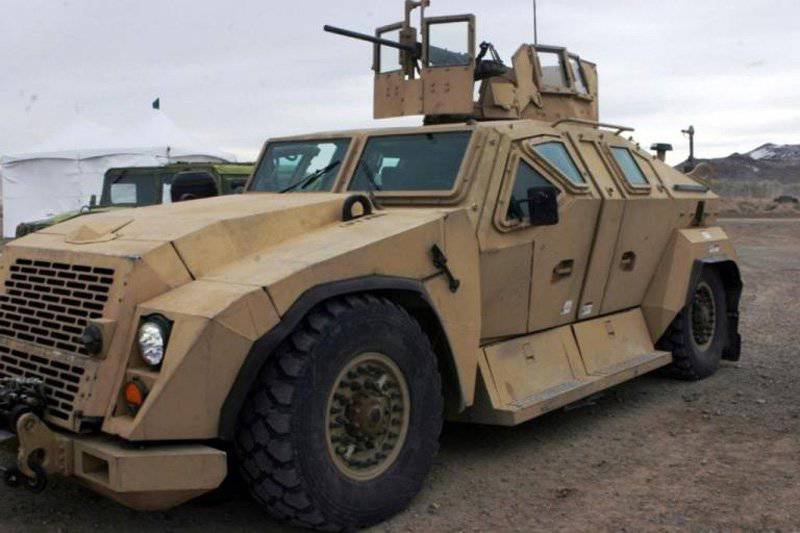
Technological demonstrator of Combat Tactical Vehicle CTV (Combat Tactical Vehicle) in the transport position (minimum ground clearance and overall height 76,4 inch) in a test car center in Nevada (NATC). The NATC and the military contractors showed the automaker community how to replace the vehicle for the Marine Corps
Modern operations involving the US military represent a future that they could not have foreseen when building ground vehicles for post-Cold War operations. It was supposed to conduct special operations abroad, which would form the basis of operational activity after the Second World War. But the disappearance of the battlefield with a clear front line and relatively safe rear areas was the result of the appearance of guerrilla warfare tactics. No one expected that the threat of IEDs would be so serious, at least to the extent that the support vehicles had to turn into combat vehicles due to the threat of attacks from all sides, including attacks from below.
The hard lessons learned in Iraq and Afghanistan made the US military focus on the future of a network of combat and tactical wheeled vehicles connected by a network that would be harder and taller, better protected than it was seen for the canceled Battle Future Systems (FCS) program. As a result, operational and tactical mobility was changed to protect the crew and landing force. The new base vehicles for the army and marines will operate along with the upgraded, reconstructed and repaired versions of the existing machines, which the troops hope to have, although they will lose mobility due to additional armor, but will maintain levels of protection at the same level.
While the quick and successful acquisition of MRAP family machines was the biggest event lately, the army is currently focused on replacing BRADLEY, revising the structure of the HMMWV car fleet and replacing them partially with JLTV (Joint Light Tactical Vehicle) lightweight tactical machines. ).
While a deep modernization program and corresponding improvements will extend the life of the BRADLEY, this very successful machine no longer matches the strategic, operational and tactical concepts of the army, partly due to the fact that its seven-person capacity with full equipment is currently insufficient . The army wants to replace it with a ground combat vehicle GCV (Ground Combat Vehicle), capable of delivering 9 soldiers to the battlefield. Initial requirements include underbody protection like the MRAP, side protection and off-road patency like the BRADLEY, urban mobility and operational mobility like the STRYKER. Other equally important goals include advanced networking capabilities, a unit cost of no more than 10,5 million dollars in 2010 prices of the year, and the delivery of the first production machines within seven years after the contract was issued.
After a refined risk assessment led to the cancellation of the initial request for GCV proposals in August 2010, the army issued a new request in November, and then in August 2011 issued technology development contracts to the teams headed by BAE Systems and General Dynamics Land Systems (GDLS) . As part of this biennial phase, preliminary design was completed and preparations began for the development and production phase (EMD) of serial machines.
JLTV and GCV programs
General light tactical vehicle JLTV (Joint Light Tactical Vehicle)
JLTV is being developed by the US Army and Marine Corps as the successor to the 11 various HMMWV variants that have been in service since 1985. In February 2011 of the year, it was announced that the contract for the EMD phase would be delayed until January or February of 2012 due to the fact that the army changed its requirements on JLTV. The Defense Ministry planned to issue two contracts for the EMD phase, the duration of which was scheduled for the 24 month, but instead its duration was 48 months.
There are two variants of the JLTV: Combat Tactical Vehicle CTV (Combat Tactical Vehicle), which will carry 4 passengers and 3500 cargo of pounds, and Combat Support Vehicle (CSV), which will carry two people and 5100 cargo of pounds.
The budget request for 2012 for the JLTV year is 172,1 million dollars for Army R & D and 71,8 million dollars for Marine R & D, which is 243,9 million dollars as a result.
In response to an excessive increase in the cost, the leadership of the army and marines apparently put aside past differences, weakening the requirements for transportability and determining a lower cost per vehicle in 225 000 dollars. In addition, the EMD phase can be trimmed to 16 months, which will be 32 months as opposed to previous 48 months.
The army and the marines point out that, despite the established emphasis on reworking HMMWV and MRAP class machines instead of developing JLTV, there are restrictions regarding the level to which machines can be upgraded while still maintaining combat effectiveness.
Another possible topic to consider is the new, lower cost JLTV machine, which may come close to the cost of a converted HMMWV. This raises the question of what is better and more economical, whether to purchase “new” JLTV or “old”, but converted HMMWV cars.
The program of the US Army ground combat vehicle GCV (Ground Combat Vehicle)
Instead of a closed program on the ground combat vehicle MGV FCS, the army decided to develop a GCV that could be involved in its spectrum of army operations and would combine the combat experience gained in Iraq and Afghanistan. The Army again issued a request for information on GCV 30 on November 2010 of the year and planned to begin the deployment of GCV in 2015 - 2017.
The budget request for 2012 for the GCV year amounted to 884,387 million dollars for R & D, reflecting a seven-month delay in the program. The National Defense Act allocated 2012 million dollars to the 449 year and stipulated that no more than 80% could be spent before the date the Minister of the Army presented a report to the defense committees containing the plans of the Minister of the Army to perform a dynamic analysis of alternative upgrades.
The possibility (availability) of the GCV also remains a key issue for Congress. The army argues that the average selling price per unit of GCV will be between 9 - 10,5 million dollars, and the average unit cost of the product will be 11 - 13 million dollars.
The Office of the Pentagon for evaluating programs and their cost estimates that the average cost of the product will be in the 16 area - 17 million. If the agency’s estimates are accurate, armies will need an extra 7,2 billion dollars to buy 1800 GCV machines.
Cost issues and schedule for GCV
Compliance even with the already revised requirements will consist of difficult trade-offs; the shadow of the 22 main army procurement programs, canceled between 1990 and 2010 over the years, hovers over GCV. The Office of Government Accountability, in a report published on October 26 of 2011 of the Year, entitled “Problems of Financing and Development of Promising Ground-Based Machines and Network Initiatives,” acknowledged various cancellation reasons and many common problems. They included: “weak cost studies or analysis of alternatives; unlimited requirements for weapons systems; underestimation of risks, especially levels of technological readiness; re-prioritization of feasibility; delayed schedules; and slow changes in requirements and technologies. ”
The Deputy Minister of Defense for Procurement, Technology and Procurement approved the program, but filed several objections, including an indication to expand the analysis of alternatives throughout the technological demonstration stage in order to reduce technical risks and production costs in the process of examining the trade-offs between specific capabilities and costs. The army should also evaluate existing combat assets to determine if a vehicle is an alternative to the new GCV or if certain capabilities of these vehicles can be included. Existing vehicles tested in this regard include the PUMA BMP from PSM Projekt System Management (a joint venture between Kraus-Maffei Wegmann (KMW) and Rheinmetall) and NAMER from Israel Military Industries (IMI). Contractors were also asked to do their own independent research themselves in order to obtain a complete comprehensive analysis of alternatives.
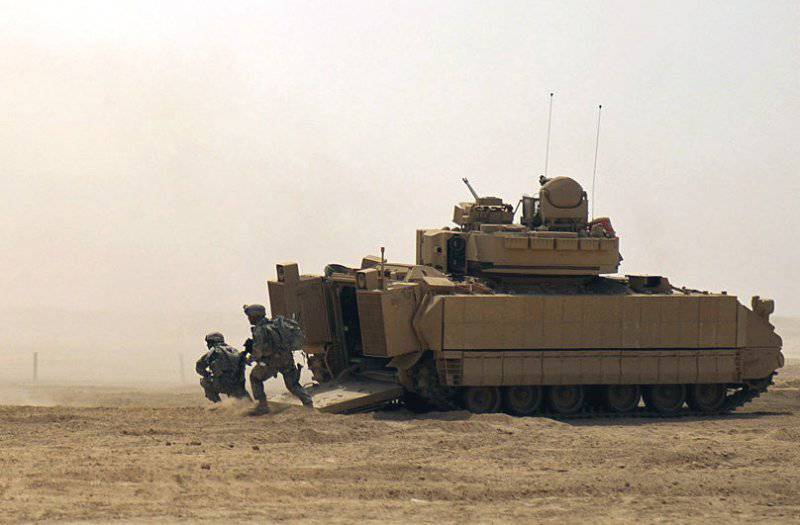
Currently, in addition to other projects, the US Army has strongly focused on replacing BRADLEY. Soldiers from the US 1 Assistance Brigade and the 17-Iraqi Division parachuted from the BRADLEY infantry combat vehicle during joint defensive exercises at the Besmayya test site 19 June 2011 of the year
The Government Accountability Office also concludes that the expected delivery of the first production vehicles seven years after issuing the contract is still risky, despite the army weakening some of the original GCV requirements and requesting contractors to use proven technology. Therefore, the Deputy Minister of Defense for Procurement, Technology and Procurement (USD / ATL) suggested the army to make the schedule more realistic, especially in light of the independent assessment provided for the review of the milestone-A stage, which is calculated from the higher development cost and 9 - 10 years to complete programs.
Due to an independent valuation, the purchase price was at least 30% higher than the price of the army, and the deputy minister said that long-term approval depends on matching the desired unit price in 13 million dollars.
The importance that the army connects with the program can be gathered from the compromises that the army is ready to make within the framework of its portfolio on the combat vehicle. Anticipating a reduction in funding in the near future, army officials intend to go ahead with the GCV project as planned, if necessary, even by reducing the modernization of the BRADLEY, ABRAMS and STRYKER fleet.
18 August 2011 company GD announced that it has received a contract for a technology demonstrator worth 439,7 million dollars, which is performed in collaboration with partners Lockheed Martin, Raytheon and power plant specialist Tognum America. The next day, BAE Systems announced its own contract for 449,9 million, which is executed with Northrop Grumman. On their prototypes, both teams must also install an RPG protection system and a test subsystem of mine protection.
The third team, which submitted an application under the leadership of SAIC consisting of KMW, Rheinmetall and Boeing, did not receive a contract for a technology demonstrator and issued an official protest to the Government Accountability Office, which was rejected on December 5 of 2011.
As the main contractor on the GCV development team, GDLS is solely responsible for managing the machine design program and integration. The company is also responsible for the design and chassis, the internal conditions of the amphibious and the crew compartments, along with the inherent safety and survivability.
The turret and all lethal and non-lethal weapons are the responsibility of Lockheed Martin along with “immersive training”; Raytheon is responsible for RPG protection, device integration beyond line of sight and sensors; GD C4 Systems leads network integration, integration of communications, computing and information; and Tognum America will provide a power unit, including an MTU diesel engine, transmission, and power generation system.
The BAE Systems-Northrop Grumman team offers a hybrid diesel-electric propulsion system. The company describes it as a robust, low-risk, cost-effective technology that allows for superior mobility with less mass than traditional systems. It also has the potential for future energy growth, as new technologies are integrated into the platform, the company said.
A key component of the hybrid powertrain is the EX-Drive electrical transmission from the Qinetiq team. Other members of the BAE Systems-Northrop Grumman Group for the GCV project are MTU, which provides a diesel engine and power generation systems; battery manufacturer Saft, responsible for energy storage; and iRobot, which integrates a ground robot with the machine and "improves future autonomous operations."
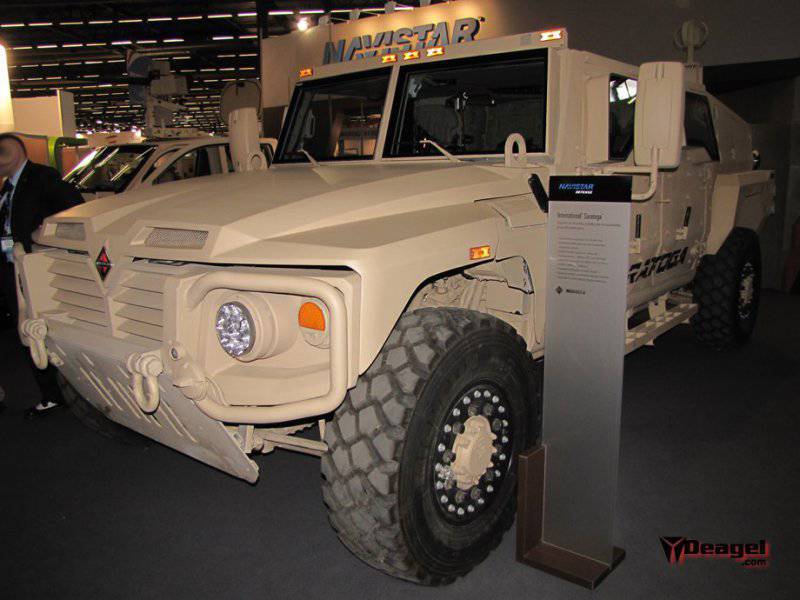
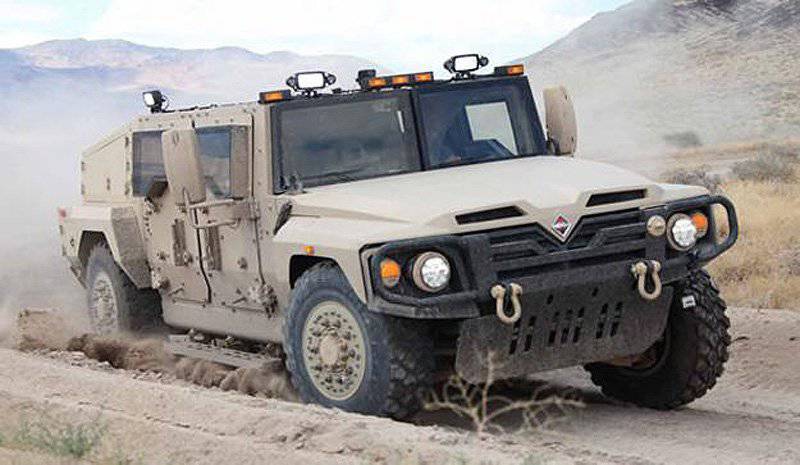
Lightweight tactical car SARATOGA from Navistar International, based on the company's extensive experience in this field, has a high degree of harmonization with field vehicles. The company also created and tested its patented geometric shape, which increases the survivability of the car. Given the combination of materials, design and body shape, Saratoga offers a more “durable” solution for the class of light tactical vehicles, while matching the transport height of 76 inches. The machine meets the most immediate needs and has traveled more than 25000 miles during sea trials. SARATOGA has a MAXXFORCE D6.0L V8 engine, automatic limited slip differentials, an Allison 2100 SP 6-SP automatic transmission, and an independent pneumatic suspension for improved handling
ABRAMS upgrades
The American army expects that the powerful ABRAMS tank manufactured by GDLS will remain in service for another decade. The newest digitized version, known as M1A2 SEPv2, entered service relatively recently in 2007, and in order to meet the new conditions, the ED and SA versions of the outdated M1A1 will pass through the integrated management program ABRAMS. MBT is also the subject of a series of incremental upgrades planned for the next decade. It is expected that, as with many other machines, maintaining the balance between size, weight, engine power and cooling system performance will be a serious task.
The System Enhancement Package (SEP) v2 includes a depleted uranium armor, digital command and control architecture, color digital maps, and new sensors. In recent modifications, additional bottom armor has already been included to repel mines and IEDs, DZ blocks for protection against cumulative projectiles and an explosion-proof seat for the driver. Also in SEPv2 installed external phone tank infantry and auxiliary power unit.
However, ABRAMS needs further modernization of its on-board power generation system and its off-road patency. The army wants to power the vetronics and sensors tank in silent mode for 12 hours, but for now using an intermediate solution of six lead-acid batteries, this period is 8 hours. The preferred solution is a sub-armored auxiliary power unit, the candidate for which is a fuel cell that extracts hydrogen from JP8 fuel and then combines it with oxygen to generate electric current and a by-product of water. Further planned upgrades for electricians include a built-in high-voltage generator to meet the expected increase in electrical loads from future upgrades, guidance sensors, network-centric communications, a sensor-shooter system, and vertical guidance guns and horizontal turret rotation.
Recent lessons have also highlighted the need for a main gun with a shorter recoil, for which the XM 360 E1 cannon is being developed. This gun, originally designed for the FCS machine, will improve the direct fire capabilities of the ABRAMS tank, while adding non-lethal weapons to increase the capabilities at the other end of the threat spectrum is discussed.
The additional weight of the new special equipment is expected to determine the need for more power and modernization of the transmission and suspension of the car.
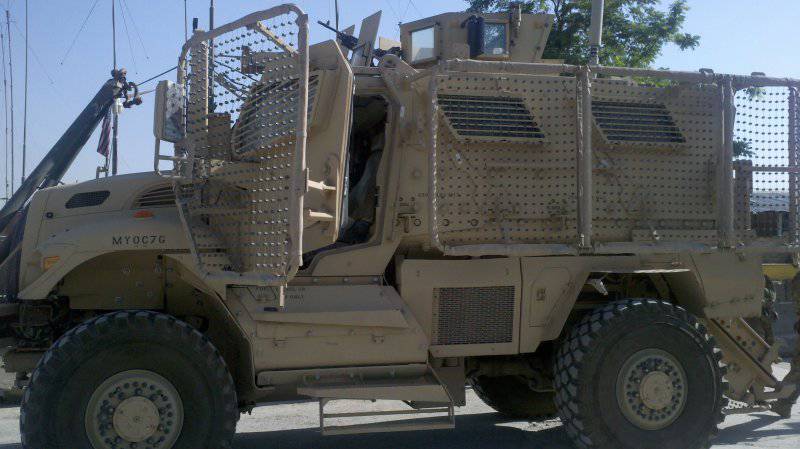
MRAP MAXXPRO is in service with the 56 th brigade battle group STRYKER. It features a wire mesh reflector. This device is bolted from both sides of the machine for additional protection against hand grenades. The MRAP on the left does not yet have such an additional component. Curved plastic tubes running from the front to the back of the MRAP are designed to safely place low-hanging electrical wires above the machine.
Marines move from EFV project to ACV project
Meanwhile, marines come to an unexpected metamorphosis of their own vision of an amphibious future introduced into the Forward From the Sea doctrine, which provides for the landing of marines from helicopters, convertible planes V22 OSPREY and Expeditionary Fighting Vehicle expeditionary combat vehicles from the horizon 25 nautical miles from the enemy coast in order to secure their landing ships and keep them at a safe distance. This requirement defined the concept of a huge and amazing EFV machine, which transforms from a boat moving at a speed of 25 knots, into a tracked infantry fighting vehicle without slowing down when entering the coast. But the concept of remoteness "fell" unable to withstand the proliferation of anti-ship long-range missiles, was demonstrated the illusion of safety of removal in 25 nautical miles. Instead of removing their landing ships even to an even greater distance in the Navy, they decided to position them closer to allow the infantry to reach the shore faster, relying on preemptive precision strikes, electronic warfare and defensive weapons in the fight against missile threats. This eliminates the need for high-speed EFV machine floats, which was the most desirable, but also problematic, issue during the development process. The EFV program was canceled in January 2011 of the year and was replaced by the less ambitious and slower ACV (Amphibious Combat Vehicle) Combat Floating Machine, through which the Marine Corps issued a request for 17 February 2011 information of the year demanding a response to 22 April 2011 of the year.
The Corps Program Manager analyzed the alternatives, which ended in the summer of 2012. In war games, the operational impact of the location of ships closer to the coast (12 nautical miles, not 25 nautical miles) and the use of slower vehicles will be evaluated. In addition, the requirements for ACV are similar to the requirements for EFV in that it is expected to transition from water to land "without a tactical pause" while maintaining the same pace with ABRAMS tanks. Also, the machine must be capable of destroying vehicles of a similar class, providing remote destruction and accurate fire from stabilized platforms and direct fire for infantry. Modular armor will adapt to the combat mission, and at the same time visual and thermal signatures (signs of visibility) will be reduced. Three options are offered: maneuverable / combat vehicle, command post and BREM.
According to current procurement plans, the ACV hull will be supplemented with new MPC (Marine Personnel Carrier) 8x8 and JLTV machines, along with an upgraded fleet of “honored” AAV machines (Amphibious Assault Vehicle) and LAV (Light Armored Vehicle). The requirements provide for two vehicles for the transportation and provision of a reinforced squad of 17 marines; each contains 8 or 9 fully equipped infantrymen and two crew members with protection superior to LAV protection. In addition to the transportation of personnel, options for command and evacuation tasks are also needed.
The program is currently at the stage of a technology demonstrator, it involves two competing teams, BAE Systems and Iveco against Lockheed Martin and Patria, the first offers the SUPER-AV option from Iveco and the second solution based on Patria AMV. The development and production phase was scheduled to begin in the 2012 year with initial operational availability in the 2018 year.
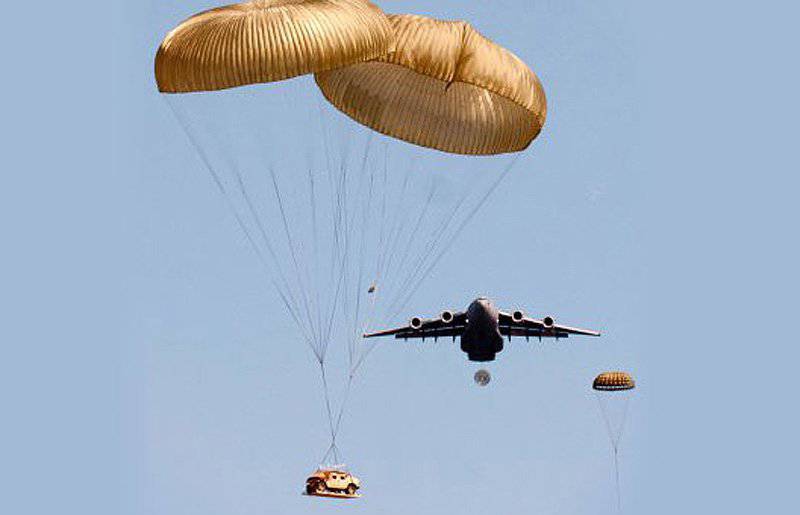
The Army and Marine Corps foresee a significant use of HMMWV in difficult tasks even after 2025, and they want to restore mobility and transportability, improve protection and reduce operating and maintenance costs.
Puzzle with light tactical machines
While performing a wide range of tasks, the army and the marines have relied on light tactical LTV (light tactical vehicles) vehicles and for the past three decades this has meant reliance on the HMMWV. However, the mass going to protect against RPGs and IEDs worsened the mobility and stability of the HMMWV. This forced the army and marines, as well as the command of special operations forces, as well as the Australian army to specify the JLTV specification, which could combine the off-road maneuverability of the original HMMWV with protection like the MRAP, while remaining light enough to be transported in C-130 and helicopters.
In accordance with the 2007 memorandum of the year issued by the Deputy Minister of Defense for Procurement, Technology and Supply, these branches of arms selected various suppliers for the technology demonstrator stage to reduce risks, evaluating candidates for JLTV from BAE Systems / Navistar, Lockheed Martin / BAE Systems and General Tactical Vehicles (consortium AM General and General Dynamics Land Systems), which supplied prototypes in May 2010.
By June 2011, the initial analysis was completed and the troops decided that the original requirements were not achievable and the machines would be too expensive. For example, it was confirmed that it was impossible to provide the required protection while maintaining transport in a helicopter, partly due to the fact that the armor remains heavier (and more expensive) than expected. As a result, the army and the marines reduced their transportability requirements by transferring some tasks from JLTV to HMMWV. Meanwhile, the requirements for the protection of the branches of troops were diverged, the army preferred elevated levels - equivalent to M-ATV, including the bottom protection, while the marines chose to retain the original protection like MRAP machines, separate bottom armor protection and reduce exposure from mines and IEDs due to more off-road driving time.
The troops now intend to make a request to the industry to provide for testing another set of prototype candidates made according to revised requirements. The central budget and control department criticized this approach for the lack of detailed project development and development tests, usually carried out earlier at the design and production stage, since there is a rather large risk of finding later that the machines are still fairly raw.
In 2010, the Main Budget Office estimated the cost of one JLTV machine according to the original specification between 306 000 and 332 000 dollars; estimates for the revised program have priced between 230 000 and 270 000 dollars. This cost prompted the Senate Armed Services Committee to recommend canceling JLTV and transferring its roles to other vehicles, including upgraded HMMWV jeeps. But the troops insisted, and Congress supported this in the defense expenditure law in 2012.
In the meantime, the request for proposals for restructuring the HMMWV fleet on the program of the upgraded machine with the advanced capabilities of MECV (Modernized Expanded Capability Vehicle) determines the price per piece 180 000 dollars plus a reservation. The army and infantry anticipate intensive HMMWV operation in harsh conditions and after 2025, and they want to regain mobility and transportability, improve protection and reduce operating and maintenance costs. Approximately 5700 of these machines with enhanced protection will be upgraded, and if financing allows, even more.
Four teams are currently competing, they are headed by AM General (the first manufacturer of HMMWV), BAE Systems, Oshkosh and finally Textron Systems in collaboration with Granite Tactical Vehicles, which created an explosive crew compartment known as the survivable tactical combat vehicle SCTV (Survivable Combat Tactical Vehicle) or “capsule”. Navistar Defense presented the International SARATOGA LTV at AUSA 2011 as a candidate for the MECV and JLTV programs.
Structural Blast Pipe
One of the vulnerabilities of the original HMMWV machine is the flat bottom, which creates a large area for the blast wave, “throwing” the machine upwards. Most solutions include mounting the V-shaped cab to the hull to deflect the blast wave around the car, but V-shaped hulls either reduce ground clearance or add height. The alternative studied by AM General is the so-called Structural Blast Tube, developed by the composite armor specialist Hardwire. This solution is a hole for the release of a blast wave up through the center of the machine, which forms a downward reaction force from the nozzles on the roof, creating resistance to lift. At the same time, such a solution may require some reduction in cabin space.
BAE Systems calls its offer ISV (Integrated Smart V - Integrated Smart V), emphasizing the high level of harmonization with HMMWV, especially the components of the power drive, wheels, brakes and electricians placed in a monocoque V-shaped case. Armor is made of steel to reduce costs, and protection can be enhanced by modular kits. The total weight of the pounds 15400 leaves the ISV solution as part of the CHINOOK helicopter's payload.
The SCTV (Survivable Combat Tactical Vehicle) survivable tactical vehicle system created by the Textron / Granite team is the center of the new integrated crew armored monocoque V-capsule, which retains most of the controls, gears and drives available. SCTV does not affect tactical mobility and air transport HMMWV with installed subsystems and proven components, it provides a low center of gravity compared with the current armored HMMWV; this system is also installed faster compared to the existing protection.
Oshkosh emphasizes the advantages of its TAK-4 independent proven suspension. The TAK-4 suspension, according to Oshkosh, has excellent performance when driving on stones, potholes and rubble due to the excellent suspension travel, stability, body height and quality, it allows you to restore the previous load carrying capacity of the Humvee with bottom armor to 2500 pounds and total weight of 18000 pounds.
The company also offers options for restoring equipment installed in theaters, upgrading HMMWV machines and “zeroing out” their mileage. Optional upgrades include a more powerful engine and enhanced drive with a choice of gear ratios between axles and hubs and power brakes.
The army plans to issue contracts to no more than three developers, who then put the prototypes. The MECV program will consist of two phases. The first stage - R & D, testing and evaluation - will focus on the arms transporter variant, although data for the personnel transporter will also be analyzed. At the second stage, R & D contractors will complete production. The upgraded options at this stage will be the control center, the ATGM transporter, the weapon transporter and the personnel module.
Completing a recent review of US combat tactical vehicle programs, the Rand Corporation (a nonprofit organization specializing in improving the policies of American society through research and analysis) identified problems in defining and meeting the requirements, stressing that the military would “always have vehicles that were created for requirements other than those they themselves face, ”due to the diversity of possible threats, scenarios and solutions. Also, "it is unlikely that the machines will ever meet the full set of desired requirements", due to the contradictions between them. It is said that the “iron triangle of compromise is constant,” and the pressure here will always increase. The final machines "may not fully meet all the requirements, but may be quite satisfactory at the same time."
Materials used:
Military Technology 2 / 2013
www.baesystems.com
www.generaldynamics.com
www.navistar.com
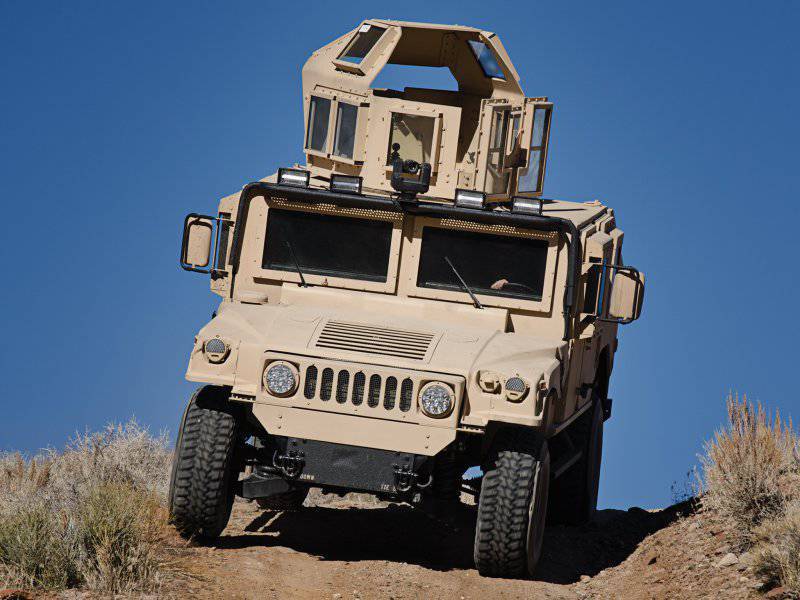
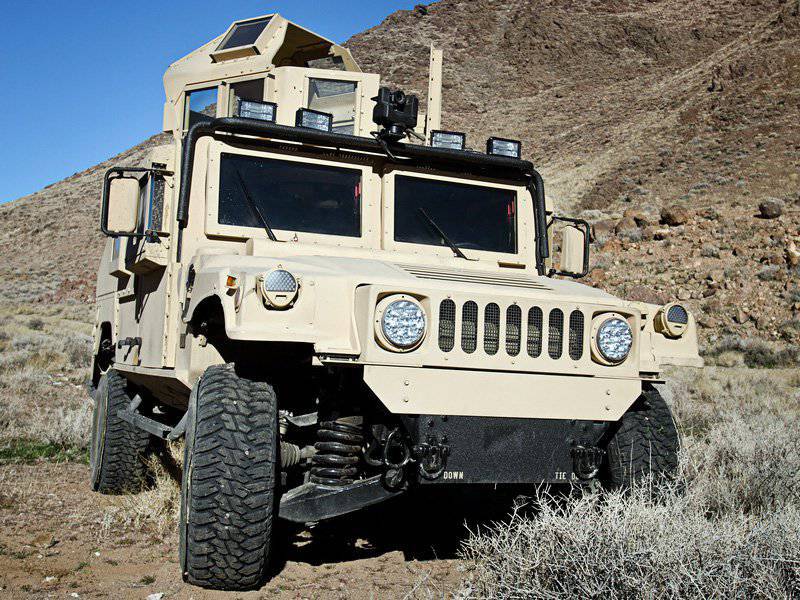
Information